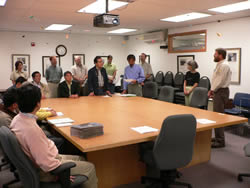
National Fire Plan Success Story
Japanese Officials Discuss Fire in the Arctic
Arctic National Wildlife Refuge, Alaska
National Fire Plan - Firefighting

Origami birds hang in a Fairbanks conference room during a meeting with Japanese environmental officials.
The possibilities associated with climate change - and the possibility that it could affect the wonders of the Arctic - prompted a delegation of environmental policy-makers from Japan to visit Alaska in August to talk with scientists from the U.S. Fish and Wildlife Service. The delegation is interested in what biologists and fire scientists know about climate change and its relationship to fire management in northern Alaska, as well as potential changes to populations of bears, moose and caribou at Arctic National Wildlife Refuge. They also expressed interest in forming studies on the subject.
Refuge Manager Richard Voss, Fire Manager Sam Patten, and other Service scientists met in Fairbanks with six members of the Japanese parliament's Committee on the Environment and staff from the Ministry of the Environment of Japan. The ecological role of wildland fire in boreal ecosystems and the potential negative consequences of aggressive fire suppression also were discussed.
Japanese interest in Alaska stems from attraction to the state as a tourist destination, especially in icy November when the aurora borealis, or northern lights, are most vivid. Most Japanese tourists also consider seeing big animals such as polar bears and brown bears the highlight of their visits to Alaska.
Arctic NWR was established in 1960. Its 19.3 million acres border two national parks in Canada and extend to the Yukon across Alaska's Brooks Range. Eight million acres are designated as federal wilderness (including three rivers) and two portions of the refuge are Research Natural Areas.